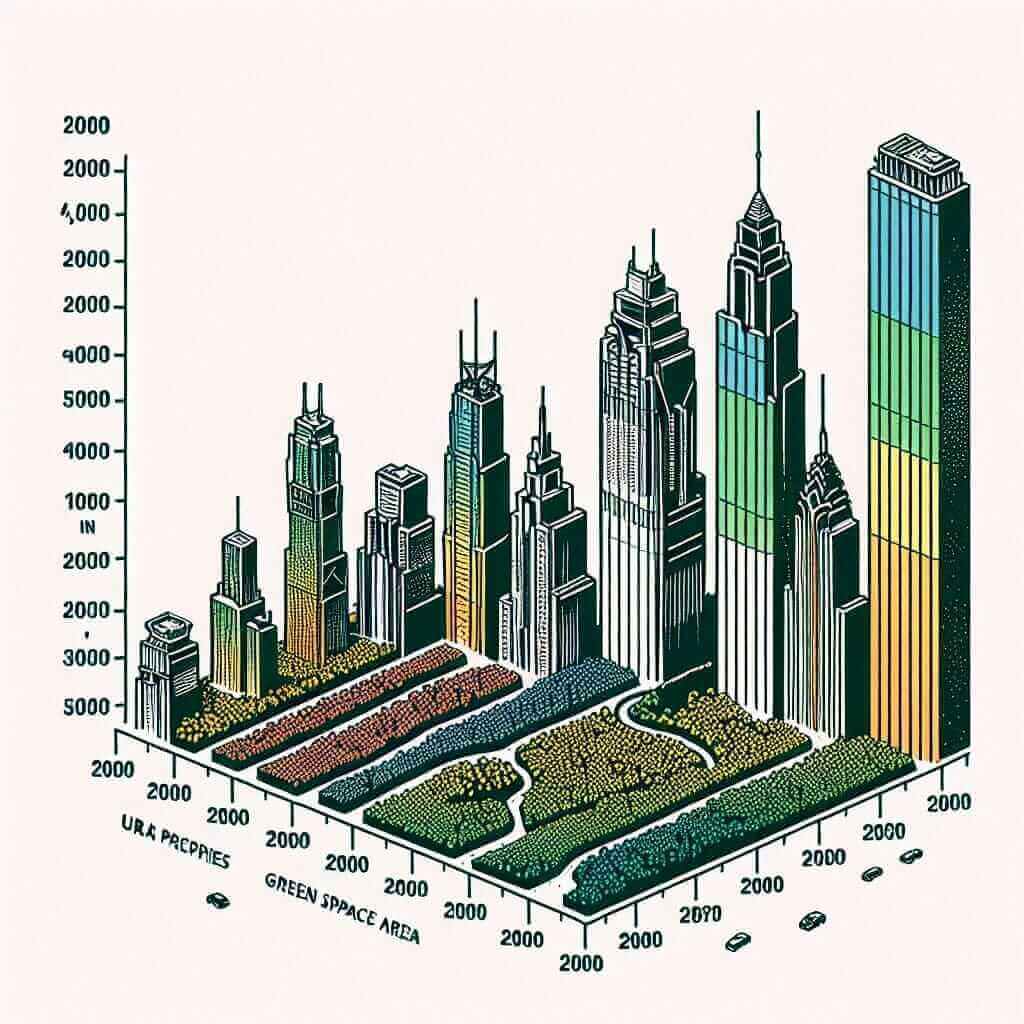Urban green space development is a topic that has increasingly appeared in various IELTS writing tasks, particularly in Task 1 where candidates often need to describe and analyze data trends. This article will delve into the trends in urban green space development over the period from 2000 to 2023, providing detailed insights and valuable tips for IELTS candidates on how to approach such tasks effectively.
Task Overview
Sample Task 1:
The chart below shows the changes in urban green space area coverage in five different cities between 2000 and 2023.
| Year | City A (ha) | City B (ha) | City C (ha) | City D (ha) | City E (ha) |
|---|---|---|---|---|---|
| 2000 | 1500 | 1300 | 900 | 1100 | 800 |
| 2005 | 1600 | 1350 | 1000 | 1200 | 850 |
| 2010 | 1650 | 1400 | 1100 | 1300 | 900 |
| 2015 | 1700 | 1500 | 1200 | 1400 | 980 |
| 2020 | 1800 | 1600 | 1300 | 1500 | 1100 |
| 2023 | 1900 | 1700 | 1400 | 1600 | 1200 |

Writing Task 1: Urban Green Space Development Trends Analysis
Introduction
The provided table illustrates the changes in the area coverage of urban green spaces measured in hectares (ha) across five cities over the span from 2000 to 2023. Overall, all the cities have seen an increase in their green space areas, with varying growth rates.
Overview
Throughout the given period, all five cities have demonstrated a continuous expansion in the amount of green space. City A consistently had the largest coverage of green areas, whereas City E started with the smallest and continues to remain the lowest, despite noteworthy growth.
Detailed Analysis
City A
City A exhibited a steady rise in green space from 1500 ha in 2000 to 1900 ha in 2023. This represents an overall increment of 400 ha over 23 years.
City B
Similarly, City B’s green space increased from 1300 ha in 2000 to 1700 ha by 2023. This city showed a moderate but consistent growth pattern amounting to an increase of 400 ha.
City C
City C saw a significant enhancement in its green area, starting at 900 ha in 2000 and reaching 1400 ha in 2023, showing an overall growth of 500 ha.
City D
City D’s urban green spaces expanded from 1100 ha to 1600 ha. This 500 ha increment suggests a substantial focus on developing green spaces.
City E
Lastly, City E began with the smallest green space area but saw a notable increase from 800 ha in 2000 to 1200 ha in 2023, expanding by 400 ha.
Tips for Writing Task 1 Responses
- Identify Trends: Always begin by identifying and summarizing the main trends shown by the data.
- Use Comparative Language: Use comparative structures to highlight differences and similarities. Example: “City A had the most substantial increase, whereas City E had the least but consistent growth.”
- Report Key Figures: Focus on pointing out key figures, especially starting and ending data points and significant milestones within the period.
- Maintain Formal Tone: Utilize formal language and avoid contractions (e.g., do not use “didn’t,” instead use “did not”).
- Use a Structure: Follow a clear structure: Introduction, Overall Trend, Detailed Analysis.
Vocabulary and Grammar Points
-
Vocabulary:
- Increment (noun) /ˈɪnkrəmənt/: an increase or addition, especially one of a series.
- Moderate (adjective) /ˈmɒdərɪt/: average in amount, intensity, quality, or degree.
- Consistent (adjective) /kənˈsɪstənt/: acting or done in the same way over time, especially so as to be fair or accurate.
- Noteworthy (adjective) /ˈnəʊtwəːði/: worth paying attention to; significant or interesting.
- Substantial (adjective) /səbˈstan(t)ʃ(ə)l/: of considerable importance, size, or worth.
-
Grammar Points:
- Comparative Structures: “larger than,” “more substantial growth,” “less than,” etc.
- Passive Voice: “The green space area was increased…”
- Present Perfect Tense: “has increased,” “has seen a rise.”
Conclusion
Understanding how to effectively describe trends and changes in data is crucial for success in the IELTS Writing Task 1. By using structured approaches, formal language, and appropriate vocabulary, candidates can deliver high-quality responses that highlight their analytical skills and command of English.
Word Count: 394 Words
By utilizing the strategies discussed and practicing with various data sets, candidates can aim to achieve a Band 7 or higher in the IELTS Writing Task 1.